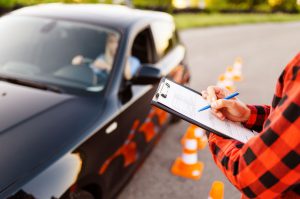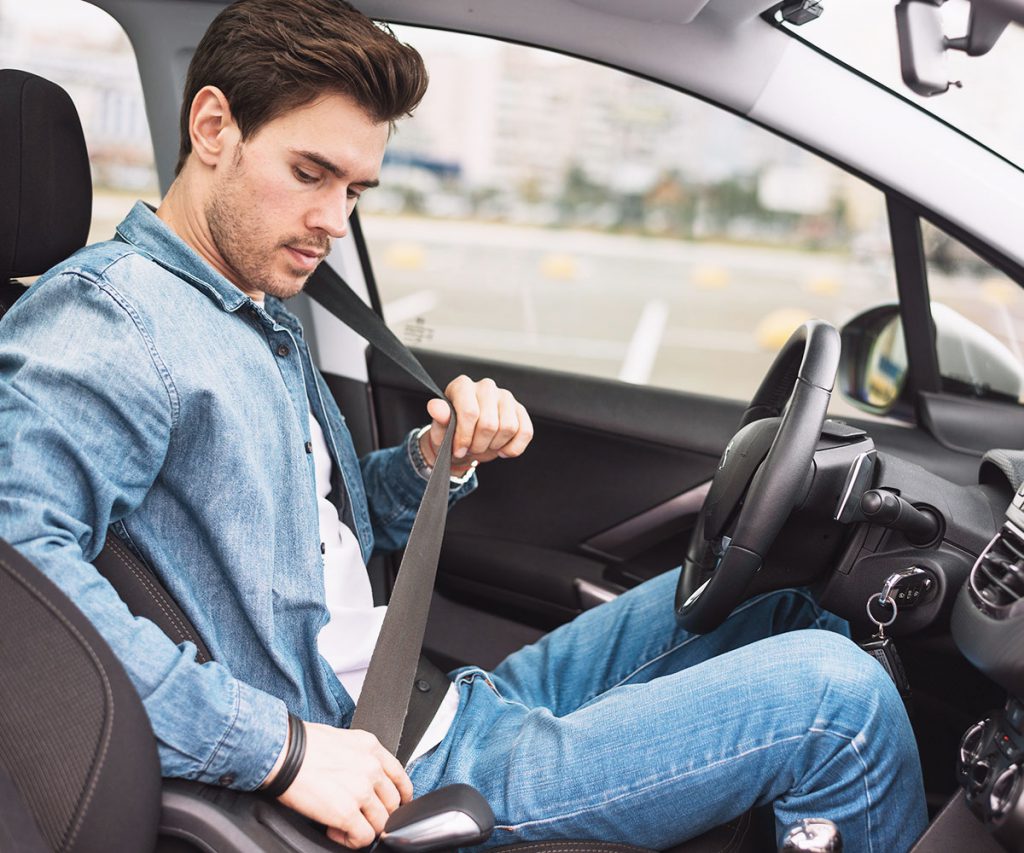You should drive at a speed suitable for the road and traffic conditions.
Anticipation and Planning is a major part of safe driving, you should be able to anticipate the actions of other road users and also plan your drive.
As part of your MSM routine you should be able to give a suitable signal, when necessary, clearly and in good time.
You should be able to apply the MSM routine when approaching and dealing with hazards making sure you check the correct mirrors for your intended manoeuvre.
After moving away you’ll need to drive in a position on the road which is safe and where you won’t become a hazard to other road users.
You should be able to move away under control and with due regard for other road users and also be able to stop the car under control in a Safe, Legal and Convenient place.
The procedure for moving off is in three parts, Preparation, Observation and then Move
Preparation
Assume that the engine is running and that you want to move off the first thing that you have to do is prepare the car, this consists of putting the clutch pedal down to the floor and selecting first gear, this is the gear that you will use for moving off on a flat road or uphill. The next thing that you must do is to set the gas; this means pressing the gas pedal slightly and holding it still, this generates sufficient power to move. Listen to the engine noise. Don’t let the engine roar! Bring the clutch up until the sound of the engine drops slightly and then keep both feet still (this is called the ‘biting point’).
Observation
You must check the road ahead and behind through all mirrors. Be prepared to wait if the road is not clear. You must also check your blindspots just as you are about to move off. As well as deciding whether it is safe to move off you must ask yourself whether it is necessary to give a signal before moving. If there is not the slightest chance of any-one being affected by you moving off, including oncoming traffic and pedestrians, there is no point in signaling. But if there is any sign of life anywhere near you, why risk it?
Move
To enable the vehicle to move off smoothly the handbrake must be taken off, and then gently increase the gas and lift the clutch up slightly, the car will begin to move off as this is done. If the car doesn’t move let the clutch up a little more. Move away only if it is safe. When the car is moving you will have to gently steer away from the kerb to the driving position about 1 metre from the kerb. To increase your speed, press the gas pedal gently and gently raise the clutch and take your foot away from the clutch pedal. You will need to change into 2nd gear soon after moving away.
Note: You should normally use 1st gear for moving off except when moving off down a steep hill, then it may be best to use 2nd gear
Stopping
When you have to pick a place to stop you must make sure that it is a safe place, you wouldn’t for example park near a junction or blocking an entrance, on a bend or before a hump-back bridge. You must also make sure that it is lawful to park and that there are no restrictions on stopping. There are many places where parking would cause an obstruction to other vehicles or road users.
Once you have selected a safe place to stop then you must use the Mirrors, Signal, Manoeuvre routine. You should never be taken by surprise when you check your mirrors because through regular checks as you drive along you will have a good idea about what is behind you. Just as important when stopping is to use the exterior mirrors with particular emphasis on the nearside mirror as there might be a cyclist in the ‘blindspot‘ area.
Having checked the mirrors and deciding that it is safe to stop you must then decide if you need to give a signal. A signal should be given if it will help or warn other road users, remember that signal will also help oncoming vehicles and any pedestrians as well as vehicles approaching from behind. A signal should always be given in good time but you must avoid giving any signal which may be misleading, for example if there is a road on the left prior to the place where you intend to stop the signal would have to be left until you have passed it.
The Manoeuvre part of the sequence involves slowing down at first by coming off the gas pedal and beginning to steer into position for stopping then use the footbrake progressively to bring the car to a stop in the proper place and close to the kerb. Just before the car stops the clutch pedal must be pushed right down to the floor to prevent the car engine stalling. When the car has stopped keep both feet still until you have applied the handbrake and moved the gear level into the neutral position.

The Driving Test
The examiner on the driving test will expect you to:-
- Move off safely and under control on a level road, from behind a parked vehicle and on a gradient
- Use the MSM routine
- Check your blindspot for traffic and pedestrians
- Make balanced use of the accelerator, clutch, brakes and steering
- Use the appropriate gear
You need to not only know what the different controls and instruments are but know how and when to use them!
It is important when driving that you do not look down at the gear stick when changing gear, although some drivers find this difficult at first it doesn’t take long to achieve. You can practice gear changes sitting in the car with the engine switched off.
In most vehicles the first 4 gears form an ‘H’ appearance on the gear lever. Neutral is the middle line in the ‘H’ formation on the gear stick. The gears run from left to right of the ‘H’, top left being first gear through to bottom right being 4th gear. Most cars now have a fifth gear which is located on the far top – right of the gear lever (to the right of the ‘H’).
To engage reverse gear you sometimes have to either push the gear lever down or lift it up towards you. Different vehicles have different setups. So always check where reverse is on a new vehicle.
1st Gear is used for moving off, manoeuvring and for creeping slowly in traffic and at junctions (approx 0 – 10mph).
2nd Gear is used for moving off down very steep hills, building up speed after moving away and driving at low speeds (approx 10 – 20mph).
3rd Gear is generally used in built up areas (approx 20 – 30mph).
4th Gear is used for driving at speeds generally higher than 30 mph, where there are no hazards to confront.
5th Gear not all vehicles have a 5th. This is normally only used on open roads when traveling constantly at higher speeds which give better fuel economy.
Block Gear Changes (part of Eco Safe driving) Some drivers have a habit of always changing through the gears one-by-one, from 1st through to 5th and from 5th through to 1st. This habit has stuck with some older drivers from when they originally learned to drive many years ago. Today, in modern cars and for everyday on-road driving, it is not generally good practice to use the gears in this way. We can change down the gears in blocks (5th to 2nd or 4th to 2nd. etc); we can equally change up in blocks (2nd to 4th or 3rd to 5th).
For example: If you are driving along at 40 mph in 4th gear, and you want to turn left into a side road you reduce your speed (using your brake) until you are going slowly enough to take the junction safely. When you have slowed down to a safe speed using the brakes, you have to select a gear that will drive the car comfortably at that speed. In most cars the best gear for the job will be 2nd. So, move the gear lever directly to the second gear position skipping 3rd. The benefits of this style of driving include better fuel economy, less overall wear and tear, less driver fatigue on long journeys and more steering control.

The Driving Test
On your driving test the examiner will expect you to:
- Use the controls smoothly and correctly
- Balance the accelerator and clutch smoothly
- Accelerate evenly
- Avoid stalling the car
- Not to ‘ride’ the clutch (keeping your left foot slightly depressed on the clutch pedal)
It is extremely important that you carry out the cockpit drill every time you enter the car and sit behind the driver’s wheel, it is equally important to check before walking into the road and opening the driver’s door. Opening a door carelessly can put you and others in danger and it may force them to brake or swerve and could cause an accident. Although not part of the cockpit drill it is also important that you check the ‘blindspot’ by looking over your right shoulder before opening your door to exit the car.
DOORS: Make sure that all the doors are firmly shut. Make sure that any passengers have closed theirs. You are responsible for the safety of your passengers. A door not properly shut may fly open as you drive along.
HANDBRAKE/GEARS: Check that the handbrake is on correctly and the gear lever is in neutral. You do not want the car moving from the weight of getting in the car or the car stalling if in a gear.
SEAT AND HEAD RESTAINT: Adjust the base of your seat so that you can operate the foot pedals easily. Ensure that you can fully depress the clutch pedal while not over stretching your left leg. If the base of the seat can be raised up and down adjust it until you can get a good view of the road ahead. Adjust the backrest of your seat so that you can reach all of the steering wheel with your arms slightly bent. Don’t get too close or you may find it awkward to lift the pedal up and you could knock your knee on the steering wheel. When adjusting the back of your seat, make sure that the ‘head restraint’ is adjusted correctly to protect your neck.
SEATBELTS: Fasten your seatbelt and make sure that your passengers fasten theirs. The law requires that all passengers wear seatbelts where fitted, unless they have an exemption certificate. It is the driver’s responsibility that children under 14 have the seat belt fastened.
MIRRORS: Adjust all of your mirrors so that you can obtain a clear view of the road behind and to the side of your vehicle, try to reduce the ‘blindspots’ to the side. When adjusting the interior mirror be careful not to touch the surface of the mirrors with your fingers.

The Driving Test
On your driving test the examiner will know you have driven to the test centre so you will not have to adjust your seat or mirrors but check the following:
- Make sure all the doors are closed.
- Ensure your handbrake is on and the gear is in neutral.
- Fasten your seatbelt.
- Start the engine.
- Check your dash for fuel levels etc..
- Turn on any lights and or windscreen wipers if necessary.
